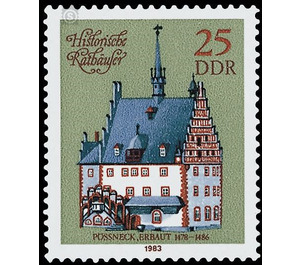Historic town halls - Germany / German Democratic Republic 1983 - 25 Pfennig
Theme: Architecture
| Country | Germany / German Democratic Republic |
| Issue Date | 1983 |
| Face Value | 25.00 |
| Color | multi-colored olive |
| Perforation | K 14 |
| Printing Type | Rotogravure 2 |
| Stamp Type | Postage stamp |
| Item Type | Stamp |
| Chronological Issue Number | 2519 |
| Chronological Chapter | GER-DDR |
| SID | 606490 |
| In 14 Wishlists | |
Historic Town Halls With the pictures of historic town halls, the Ministry of Posts and Telecommunications of the German Democratic Republic publishes four multicolored special postage stamps. Special cancellations from February 22 to April 21, 1983 Historical town halls 25-pfennig value: Pößneck The town hall in Pößneck was begun as a spötgotic building in 1478. The outer shape is characterized by early Renaissance forms, which are particularly evident in the two stepped gables on the narrow sides. At the front is a covered staircase with semicircular gables. On the ground floor is a zweischiffige hall with six cross vaults, today used as Ratskeller. Conversions were made at the end of the 19th century.


